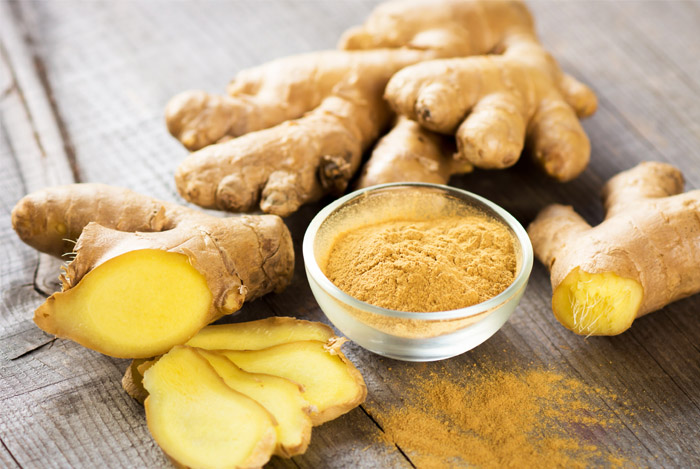The History of Ginger

I eat raw ginger in its whole tuber form and even enjoy its spicy bite. I eat it raw because it has some very good therapeutic benefits. The benefits of raw and powdered ginger have been known for thousands of years by various cultures all around the world. Asian, Indian, and Arabic herbal traditions made good use of the root, over the last 4500 years.
One name it is known by in China is Sheng jiang; an early medical book in China written about 2000 BCE discusses medical treatments using the ginger root.
A stewed-meal using ginger is mentioned, in one of the two major Sanskrit epics of ancient India, called the Mahabharata (circa 4th century BC). Ginger has also been a key plant to use in Ayurvedic medicine, which is a system of traditional medicine native to the Indian subcontinent. Ginger has been written about in the Charka Samhita and the Sushruta Samhita, both Ayurvedic texts discussing ginger treatements. In Sanskrit it is known as Ardrake, Vishvabheshaja, Sunthi and Srngaveran or horned root.
Ginger was also exported from India into the Roman culture where it was used for its culinary properties. Records show that it was taxed as it came into Rome by way of Alexandria. Its Latin name is Zingiber officinale. After Rome fell, the supply of ginger was tightly controlled by Arab traders and sold to various European markets. The name ginger actually comes from the Middle English word gingivere.
Black pepper, ginger and cinnamon were the most commonly traded spices during the 13th and 14th centuries. It has been noted in the annals of history that by the 16th century the cost of one pound in weight of ginger in England would cost a man the equivalent of one sheep.
Traveling Arabs planted the rhizomes and spread the herb throughout Africa and Zanzibar. The root, or what is called the rhizome of this plant is called Zingiber, Raw ginger has a bit of a bite to it but try using it. There are benefits to help treat arthritis, heart conditions, colic, and diarrhea. Ginger use is a known remedy for flu, chills, irritable bowel, menstrual cramps, loss of appetite, cold, bronchitis, poor circulation, stomach cramps, fever, headache, toothache, coughing.
The healers Meddygon Myddvai were Rhiwallow, and his sons, Cadwgan, Gruffydd, and Einiow named in the book the Fairy Legends and Traditions of the South of Ireland. In great detail ginger is mentioned in the book Physicians of Myddvai, a 13th century book written by Rhiwallow on order of the Prince of South Wales.
After Rome fell, much of the known uses for ginger were forgotten and access to it was more difficult. In Marseilles a tariff was placed upon ginger imports in the 12 century. By the 14th century, the only spice more popular than ginger, was black pepper and then cinnamon.
Recipes of gingerbread are written about in early books from the 14th & 15th centuries. The recipes listed are more for a treat that is less of a pastry and more of a confection, such as a candy, but it is purported to be tasty. Chaucer’s Sir Thopas in Canterbury Tales ate these confections.
“They fette hym first the sweete wyn, and mede eek in a mazelyn, and roial spicerye of gyngebreed that was ful fyn, and lycorys, and eek comyn, with sugre that is trye.”
The gingerbread man cookie was a popular Christmas treat purportedly created by Queen Elizabeth I of England (1533-1603) after her father Henry VIII began recommending it as remedy for the plague.
Spanish Conquistadors brought ginger into the New World and soon Caribbean countries like Jamaica, and Brazil would trade in ginger. Infusions and decoctions of ginger were used by Native Americans. Ginger was even used to relieve flatulence and to flavor their foods. Ginger could be boiled down to a syrup that was used on food items. Some tribes and woodsmen used ginger in their poultices. They instinctively were on to something, that our medical researchers have confirmed today; ginger has benefits. Researchers identified two antibiotic compounds in the plant. If you have an upset stomach try something natural like ginger rather than the chemical laden junk out there.

Today we have ginger beer, pastries, candies and more. For those who are in the outdoors, think about its benefits to you. My mother used to proscribe it to my sister when she was pregnant with her first child. Coming to visit from Okinawa, my sister ill from pregnancy, so she drank a tea made with ginger shavings. Ginger tablets are sold in stores.
How to identify Wild Ginger
You want to find tubers that are heavy for their size. They should have a spicy fragrance and be firm, with a smooth skin. Avoid tubers that have wrinkled flesh. The texture will be different when you chew on it; go for firmer ginger tubers. Store dried ginger in your pantry or cupboard where its dark for up to three months. Keep it in a cool, dark spot and it will server you well.
Ginger has been used by Native Americans in this country for many a long time as a seasoning and also a medicinal herb. Here are some of the known benefits of using ginger:
- Cold and Flu Prevention.
- Colon Cancer Prevention.
- Combats Morning Sickness.
- Combats Stomach Discomfort.
- Fights Common Respiratory Problems.
- Improves absorption.
- Maintains Normal Blood Circulation.
- Ovarian Cancer Treatment.
- Reduces Pain and Inflammation.
- Remedies Motion Sickness.
- Strengthens Immunity.
picture By McCormick and company [Public domain], via Wikimedia Commons


